battery YAMAHA TTR50 2006 Notices Demploi (in French)
[x] Cancel search | Manufacturer: YAMAHA, Model Year: 2006, Model line: TTR50, Model: YAMAHA TTR50 2006Pages: 390, PDF Size: 9.69 MB
Page 179 of 390
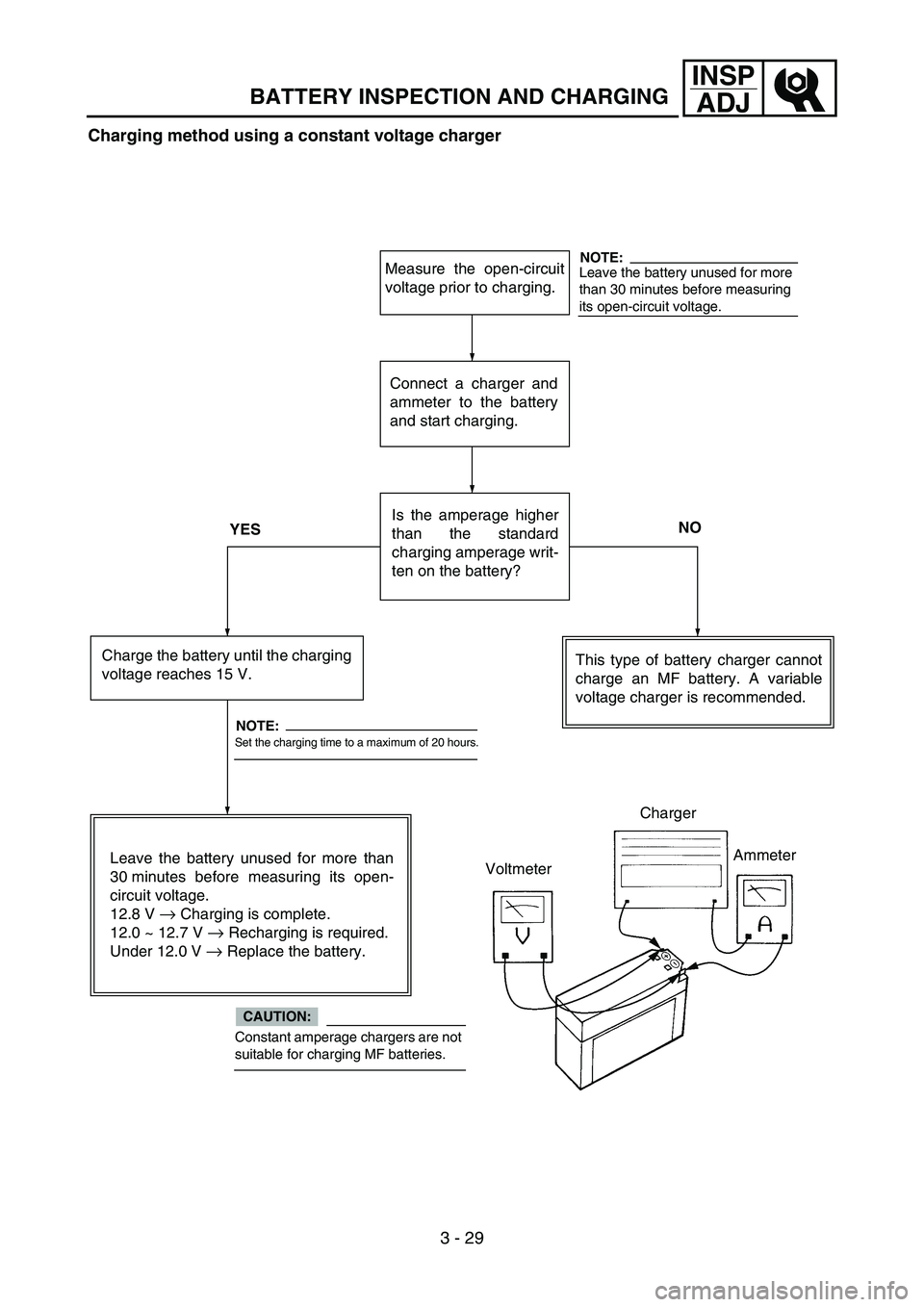
3 - 29
INSPADJ
BATTERY INSPECTION AND CHARGING
Charging method using a constant voltage charger
Measure the open-circuit
voltage prior to charging.
Connect a charger and
ammeter to the battery
and start charging.
NO
YES Is the amperage higher
than the standard
charging amperage writ-
ten on the battery?
Charge the battery until the charging
voltage reaches 15 V.
Leave the battery unused for more than
30 minutes before measuring its open-
circuit voltage.
12.8 V
→ Charging is complete.
12.0 ~ 12.7 V
→ Recharging is required.
Under 12.0 V
→ Replace the battery. This type of battery charger cannot
charge an MF battery. A variable
voltage charger is recommended.
Leave the battery unused for more
than 30 minutes before measuring
its open-circuit voltage.
Set the charging time to a maximum of 20 hours.
Constant amperage chargers are not
suitable for charging MF batteries.
Charger
Ammeter
Voltmeter
NOTE:
CAUTION:
NOTE:
Page 184 of 390
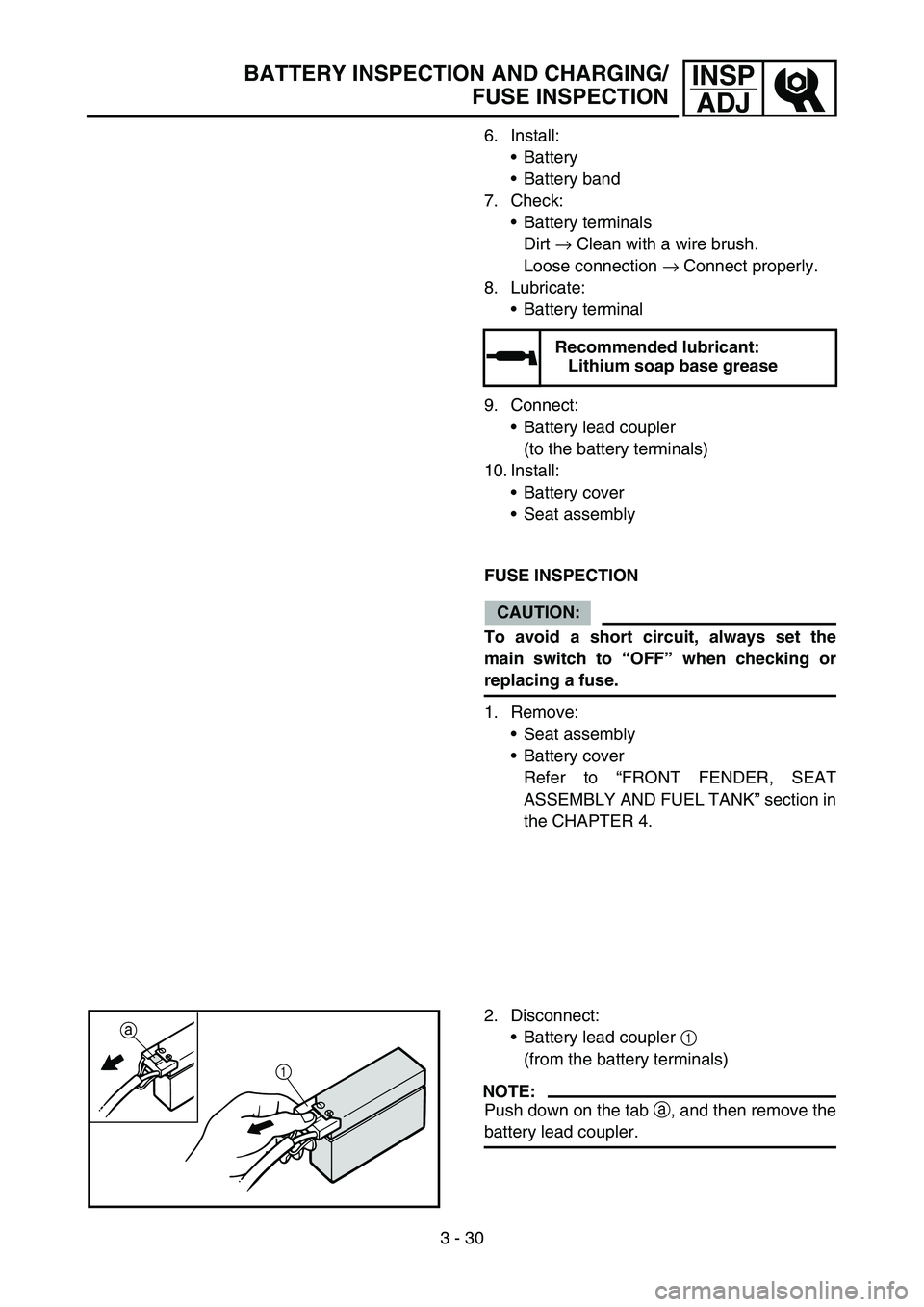
3 - 30
INSPADJBATTERY INSPECTION AND CHARGING/
FUSE INSPECTION
6. Install:
Battery
Battery band
7. Check: Battery terminals
Dirt → Clean with a wire brush.
Loose connection → Connect properly.
8. Lubricate: Battery terminal
9. Connect: Battery lead coupler
(to the battery terminals)
10. Install:
Battery cover
Seat assembly
Recommended lubricant:
Lithium soap base grease
FUSE INSPECTION
CAUTION:
To avoid a short circuit, always set the
main switch to “OFF ” when checking or
replacing a fuse.
1. Remove:
Seat assembly
Battery cover
Refer to “FRONT FENDER, SEAT
ASSEMBLY AND FUEL TANK ” section in
the CHAPTER 4.
2. Disconnect: Battery lead coupler 1
(from the battery terminals)
NOTE:
Push down on the tab a, and then remove the
battery lead coupler.
1
a
Page 186 of 390
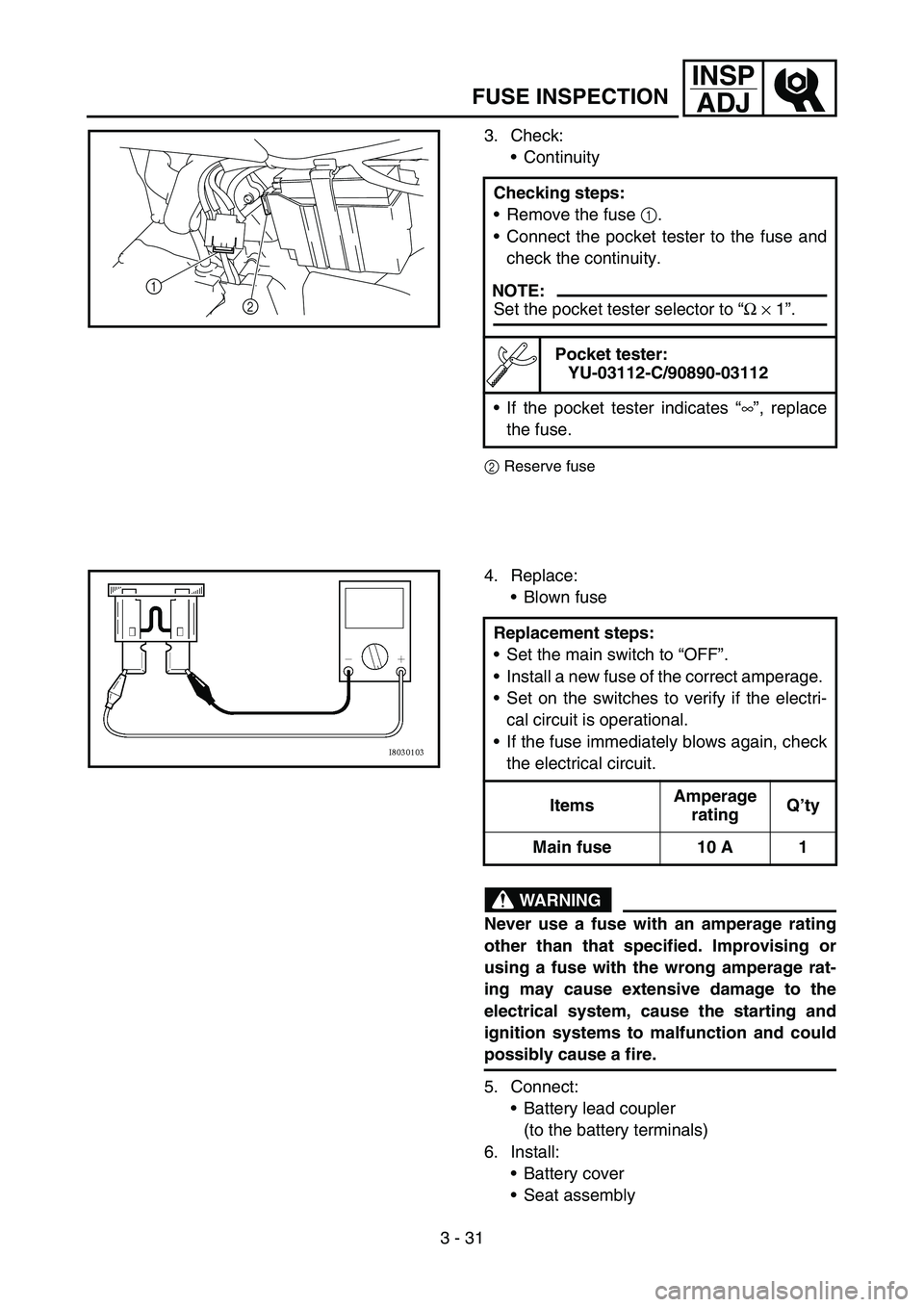
3 - 31
INSPADJ
FUSE INSPECTION
3. Check:
Continuity
2 Reserve fuse
Checking steps:
Remove the fuse 1
.
Connect the pocket tester to the fuse and
check the continuity.
NOTE:
Set the pocket tester selector to “Ω × 1 ”.
Pocket tester:
YU-03112-C/90890-03112
If the pocket tester indicates “∞ ”, replace
the fuse.
1 2
4. Replace:
Blown fuse
WARNING
Never use a fuse with an amperage rating
other than that specified. Improvising or
using a fuse with the wrong amperage rat-
ing may cause extensive damage to the
electrical system, cause the starting and
ignition systems to malfunction and could
possibly cause a fire.
5. Connect:
Battery lead coupler
(to the battery terminals)
6. Install: Battery cover
Seat assembly
Replacement steps:
Set the main switch to “OFF ”.
Install a new fuse of the correct amperage.
Set on the switches to verify if the electri-
cal circuit is operational.
If the fuse immediately blows again, check
the electrical circuit.
Items Amperage
rating Q
’ty
Main fuse 10 A 1
Page 188 of 390
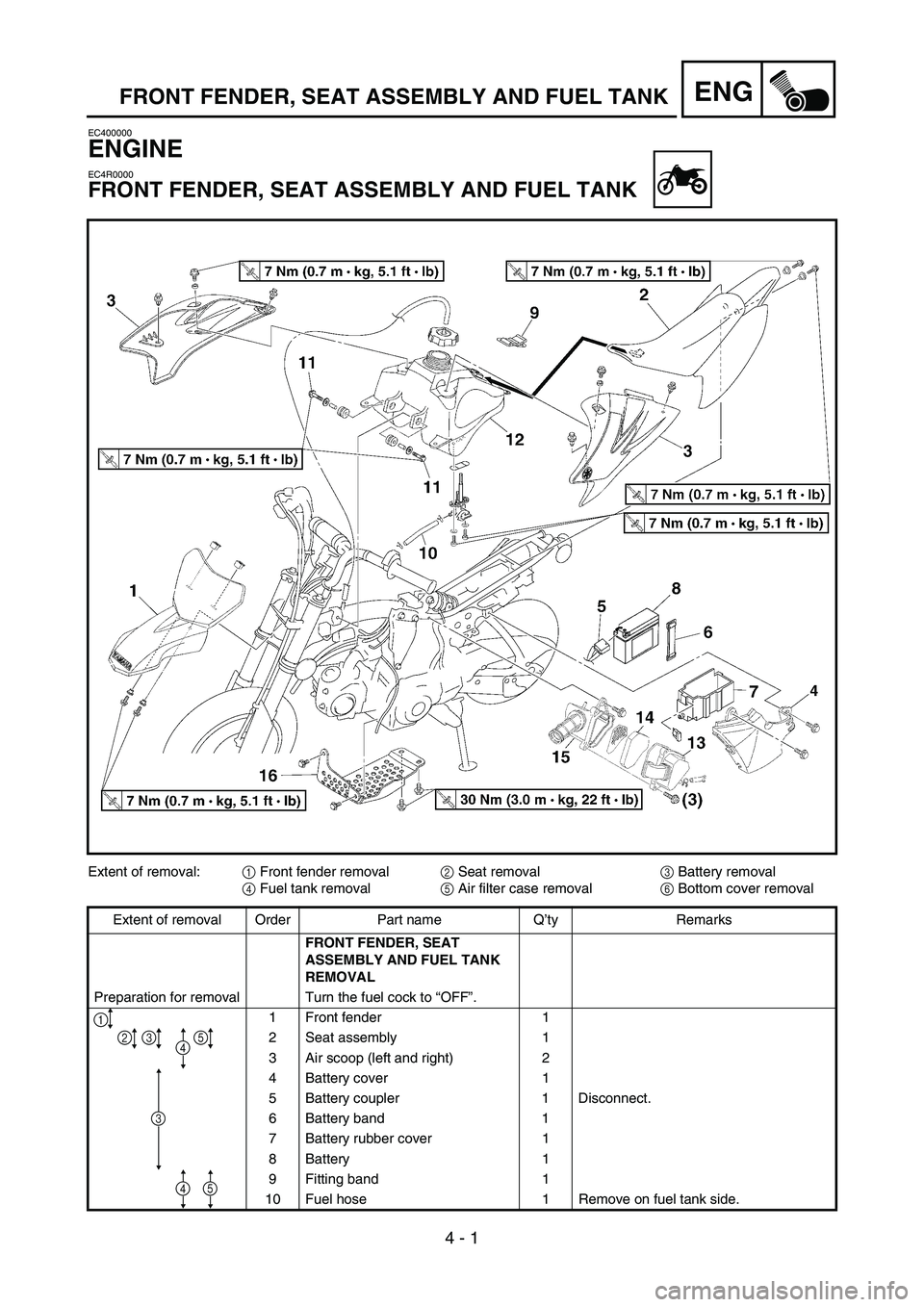
4 - 1
ENGFRONT FENDER, SEAT ASSEMBLY AND FUEL TANK
EC400000
ENGINE
EC4R0000
FRONT FENDER, SEAT ASSEMBLY AND FUEL TANK
Extent of removal:1 Front fender removal
2 Seat removal
3 Battery removal
4 Fuel tank removal
5 Air filter case removal
6 Bottom cover removal
Extent of removal Order Part name Q ’ty Remarks
FRONT FENDER, SEAT
ASSEMBLY AND FUEL TANK
REMOVAL
Preparation for removal Turn the fuel cock to “OFF ”.
1 Front fender 1
2 Seat assembly 1
3 Air scoop (left and right) 2
4 Battery cover 1
5 Battery coupler 1 Disconnect.
6 Battery band 1
7 Battery rubber cover 1
8 Battery 1
9 Fitting band 1
10 Fuel hose 1 Remove on fuel tank side.
1
2
3
43
4
5
5
Page 340 of 390

6 - 1
–+ELEC
345
6
78
\b0
B\f
2
1
ELECTRICAL COMPONENTS AND WIRING DIAGRAM
EC600000
ELECTRICAL
EC610000
ELECTRICAL COMPONENTS AND WIRING DIAGRAM
EC611000
ELECTRICAL COMPONENTS
1 Thermo switch
2 Main switch
3 Engine stop switch
4 Ignition coil
5 Ground lead
6 Fuse
7 Battery
8 CDI unit
9 Starter relay 0
Rectifier/regulator
A Neutral switch
B AC magneto
C Carburetor heater
D Start switch
E Spark plug
F Starter motorCOLOR CODE
B ...................... Black
Br .................... Brown
O ..................... Orange
R ..................... Red
Sb .................... Sky blue
W ..................... White
Y ...................... Yellow
EC612000
WIRING DIAGRAM
R
WR
W
BL /WSb B
RW
W
W
OO
B
B
Y /R
R
W
B
R
Y /RY /R
Y
ON
OFF
OFF ON
Y
B
BY
/RRB
SbY /RR B
W
B
B
RBrR
Br
R
/WBr
R /W
L /W
OFF
RUN
Sb
BrBr
Sb
WBY
/RW SbY
B
B
B
RR
RR
R
R
R
/W
L /W
RRRB
R /W
L
/WR
R
RR
B Br
BO
R
WB
\f
2 8
4
E
1
C
D
0
63
\b F
5 7
Br
L/W .................. Blue/White
R/W .................. Red/White
Y/R ................... Yellow/Red
E
F
D
C
Page 352 of 390
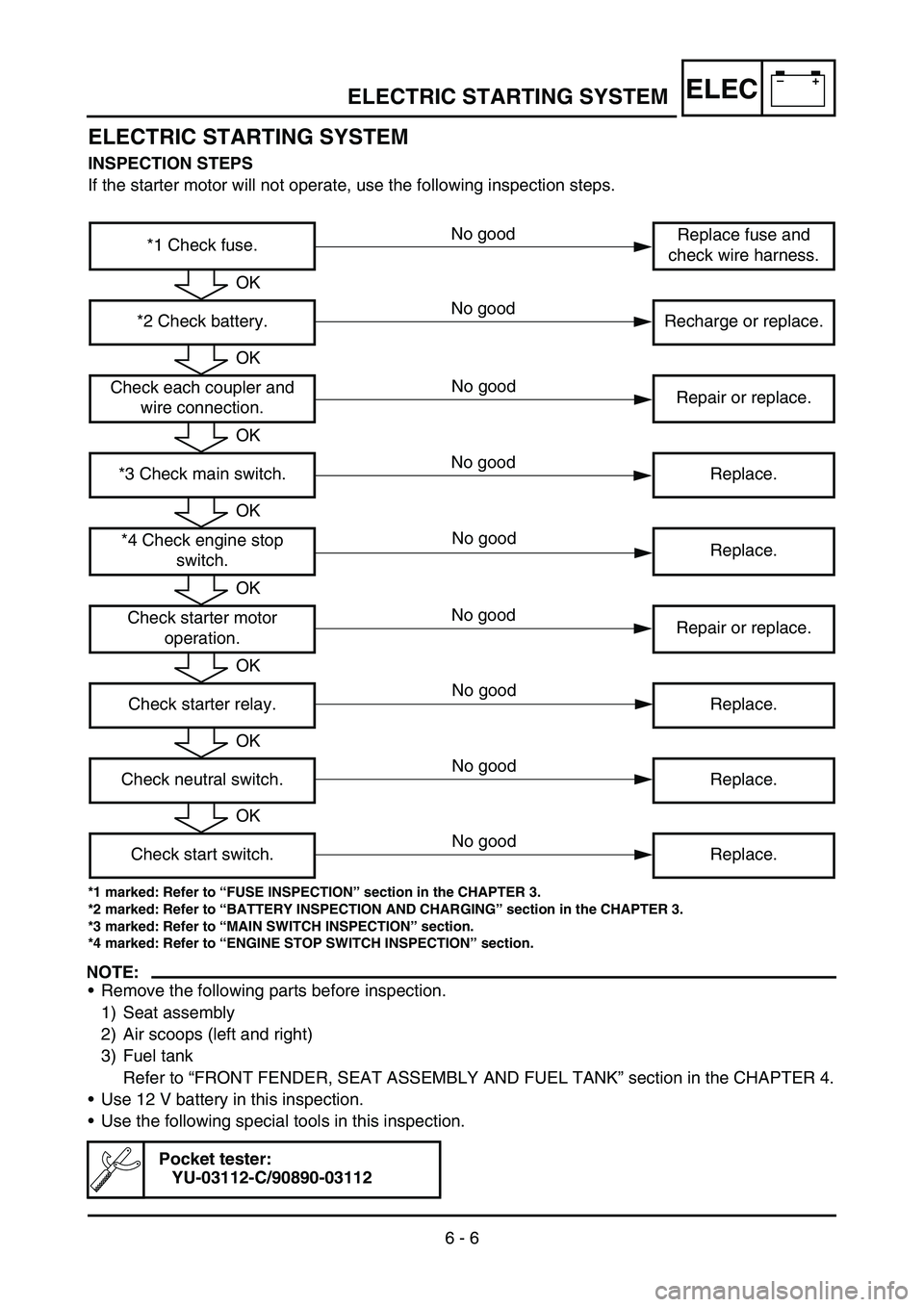
–+ELEC
6 - 6
ELECTRIC STARTING SYSTEM
INSPECTION STEPS
If the starter motor will not operate, use the following inspection steps.
*1 marked: Refer to “FUSE INSPECTION ” section in the CHAPTER 3.
*2 marked: Refer to “BATTERY INSPECTION AND CHARGING ” section in the CHAPTER 3.
*3 marked: Refer to “MAIN SWITCH INSPECTION ” section.
*4 marked: Refer to “ENGINE STOP SWITCH INSPECTION ” section.
NOTE:
Remove the following parts before inspection.
1) Seat assembly
2) Air scoops (left and right)
3) Fuel tank
Refer to “FRONT FENDER, SEAT ASSEMBLY AND FUEL TANK ” section in the CHAPTER 4.
Use 12 V battery in this inspection.
Use the following special tools in this inspection.
Pocket tester:
YU-03112-C/90890-03112
*1 Check fuse. Replace fuse and
check wire harness.
*2 Check battery. Recharge or replace.
Check each coupler and wire connection. Repair or replace.
*3 Check main switch. Replace. *4 Check engine stop switch. Replace.
Check starter motor operation. Repair or replace.
Check starter relay. Replace.
Check neutral switch. Replace. Check start switch. Replace.
OK
OK
OK
OK
OK
OK
OK
OK
No good
No good
No good
No good
No good
No good
ELECTRIC STARTING SYSTEM
No good
No good
No good
Page 356 of 390
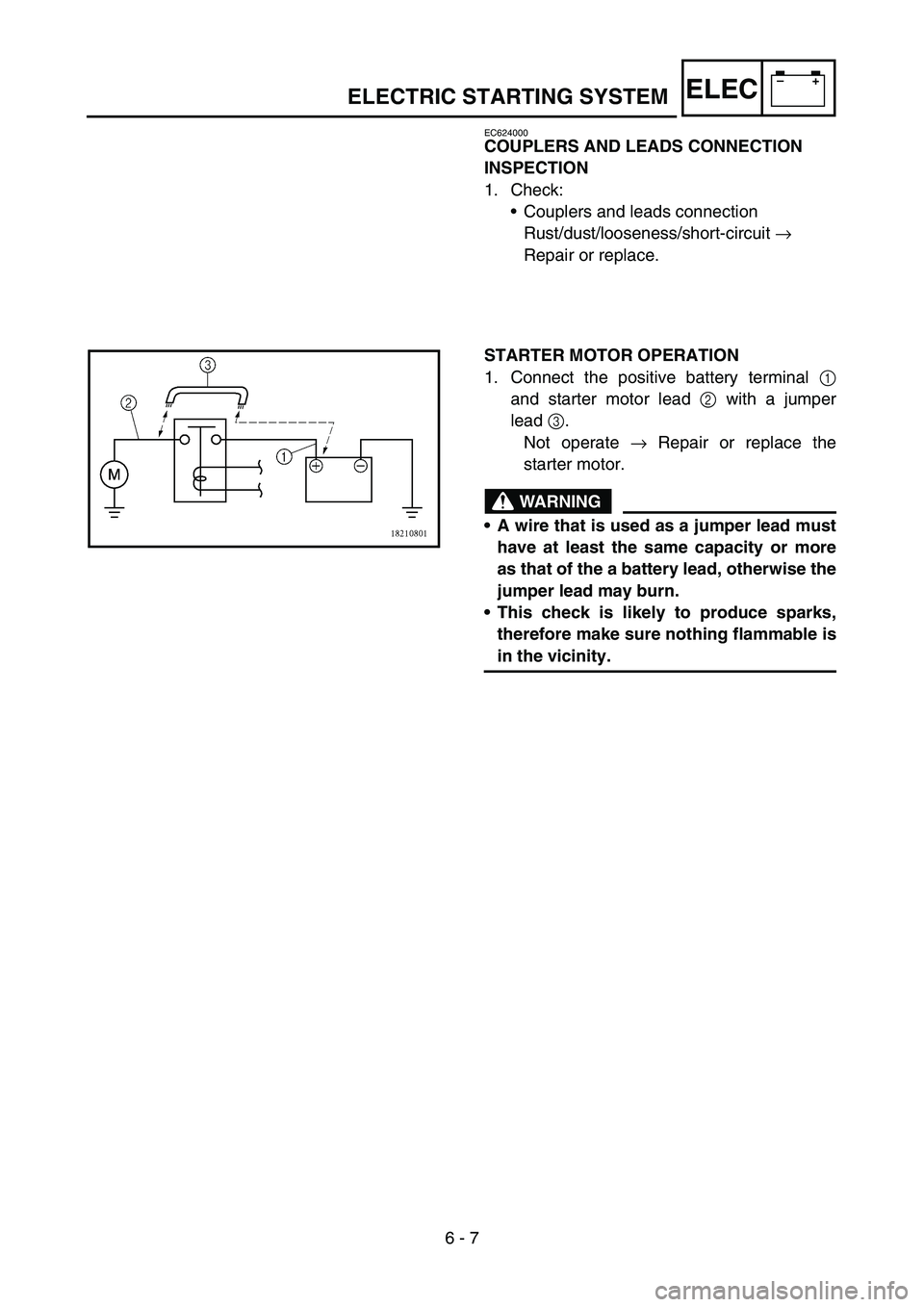
6 - 7
–+ELEC
EC624000
COUPLERS AND LEADS CONNECTION
INSPECTION
1. Check:
Couplers and leads connection
Rust/dust/looseness/short-circuit →
Repair or replace.
STARTER MOTOR OPERATION
1. Connect the positive battery terminal 1
and starter motor lead 2 with a jumper
lead 3.
Not operate → Repair or replace the
starter motor.
WARNING
A wire that is used as a jumper lead must
have at least the same capacity or more
as that of the a battery lead, otherwise the
jumper lead may burn.
This check is likely to produce sparks,
therefore make sure nothing flammable is
in the vicinity.
ELECTRIC STARTING SYSTEM
Page 358 of 390
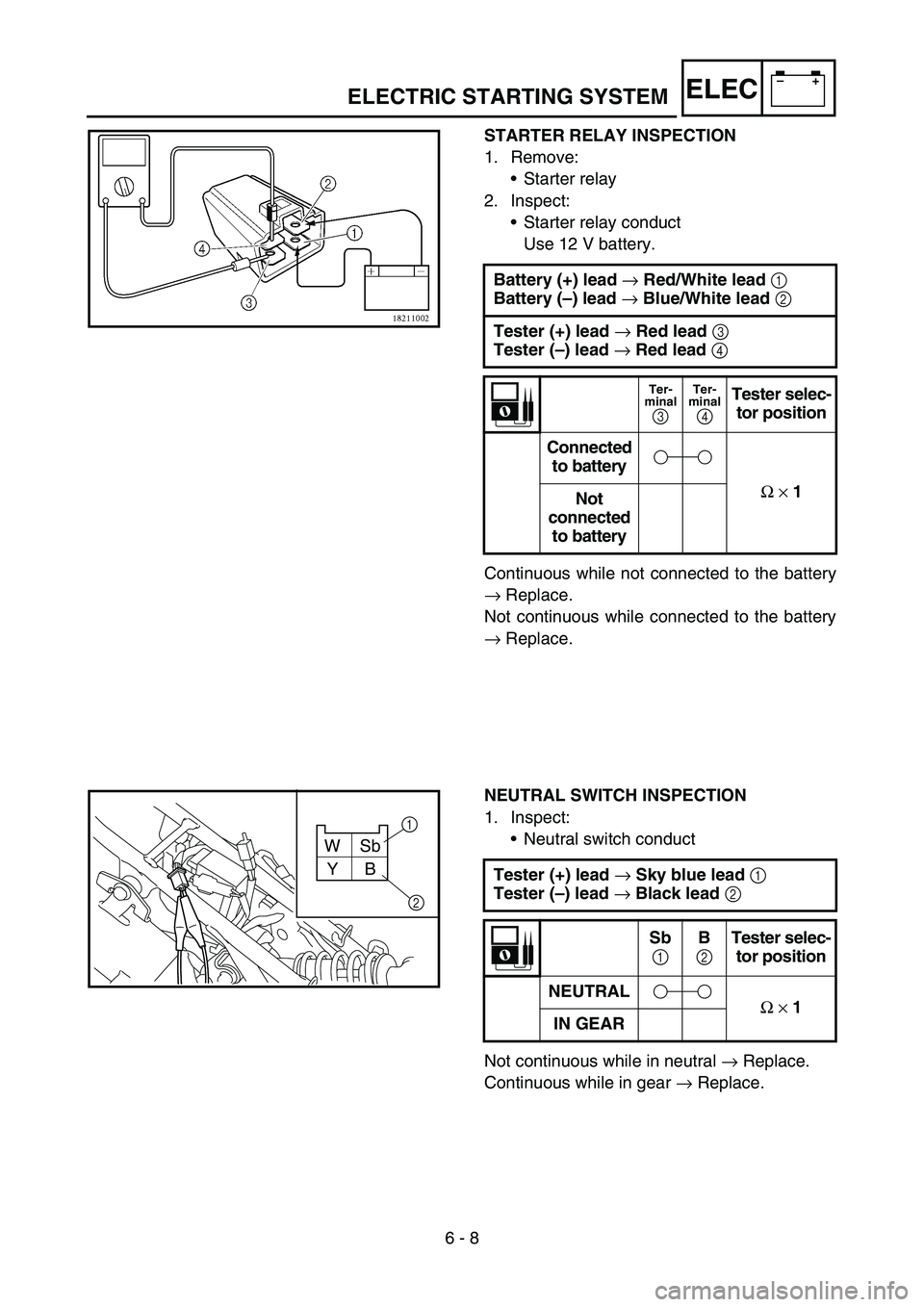
6 - 8
–+ELEC
STARTER RELAY INSPECTION
1. Remove:
Starter relay
2. Inspect: Starter relay conduct
Use 12 V battery.
Continuous while not connected to the battery
→ Replace.
Not continuous while connected to the battery
→ Replace.
Battery (+) lead
→ Red/White lead 1
Battery ( –) lead → Blue/White lead 2
Tester (+) lead → Red lead 3
Tester ( –) lead → Red lead 4
Ter-
minal
3
Ter-
minal
4 Tester selec-
tor position
Connected to battery
Ω × 1
Not
connected to battery
NEUTRAL SWITCH INSPECTION
1. Inspect:
Neutral switch conduct
Not continuous while in neutral → Replace.
Continuous while in gear → Replace.
Tester (+) lead
→ Sky blue lead 1
Tester ( –) lead → Black lead 2
Sb
1 B
2 Tester selec-
tor position
NEUTRAL Ω × 1
IN GEAR
WSb
B
Y 1
2
ELECTRIC STARTING SYSTEM
Page 370 of 390
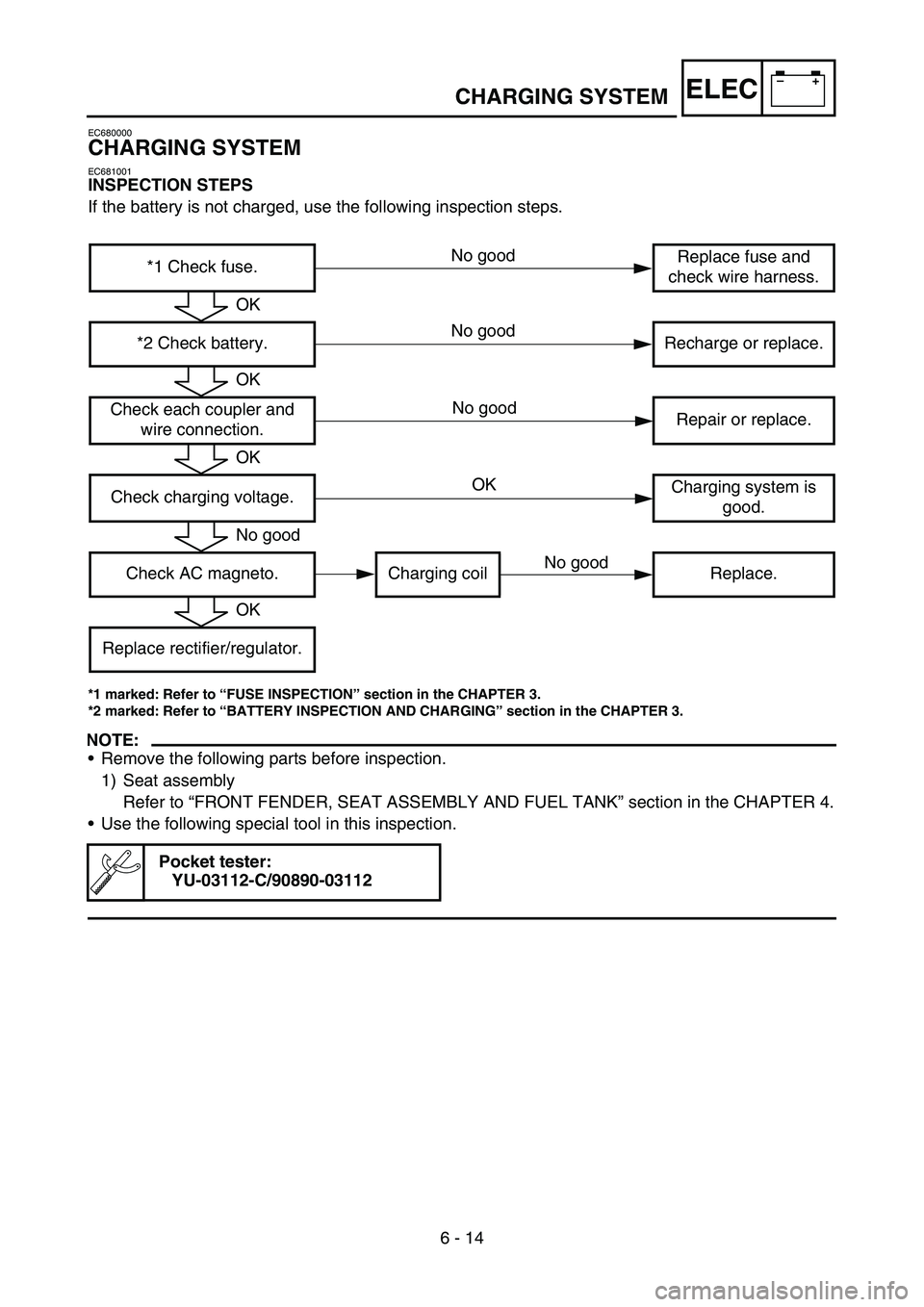
–+ELEC
6 - 14
CHARGING SYSTEM
EC680000
CHARGING SYSTEM
EC681001
INSPECTION STEPS
If the battery is not charged, use the following inspection steps.
*1 marked: Refer to “FUSE INSPECTION ” section in the CHAPTER 3.
*2 marked: Refer to “BATTERY INSPECTION AND CHARGING ” section in the CHAPTER 3.
NOTE:
Remove the following parts before inspection.
1) Seat assembly
Refer to “FRONT FENDER, SEAT ASSEMBLY AND FUEL TANK ” section in the CHAPTER 4.
Use the following special tool in this inspection.
Pocket tester:
YU-03112-C/90890-03112
*1 Check fuse. Replace fuse and
check wire harness.
*2 Check battery. Recharge or replace.
Check each coupler and wire connection. Repair or replace.
Check charging voltage. Charging system is
good.
Check AC magneto. Charging coil Replace.
Replace rectifier/regulator.
OK
OK
OK
No good
OK
No good
OK
No good
No good
No good